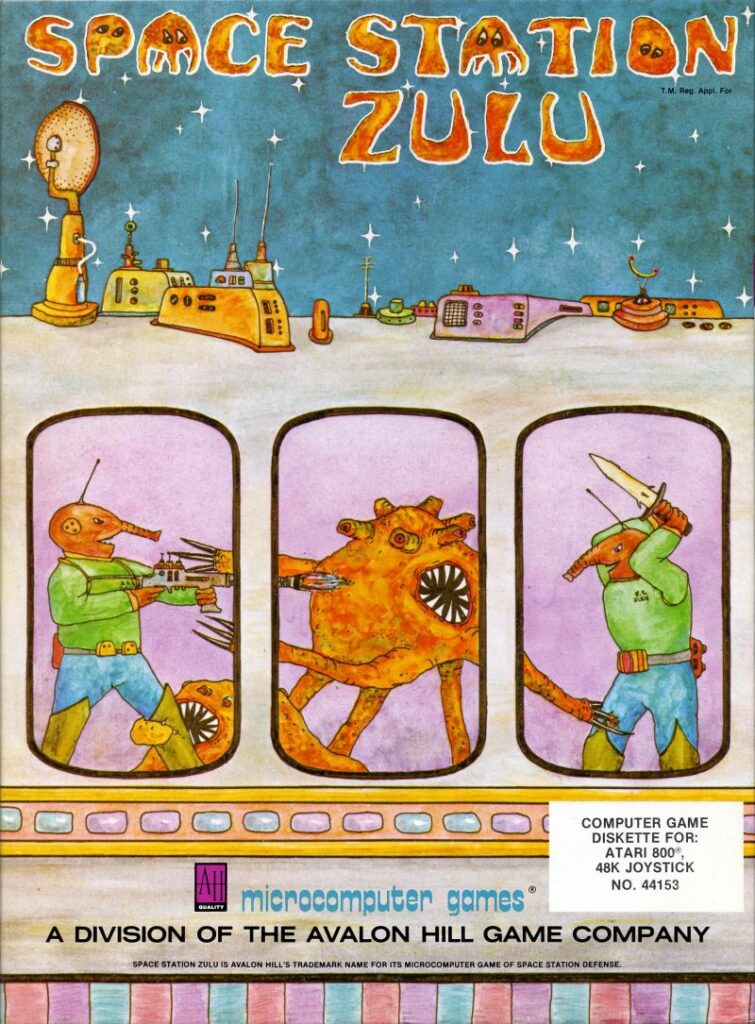
Lieutenant Narwhal ! Hope your holidays at the beach on Coral Sea went well ! We are finding ourselves in dire need of assistance (again). But first …
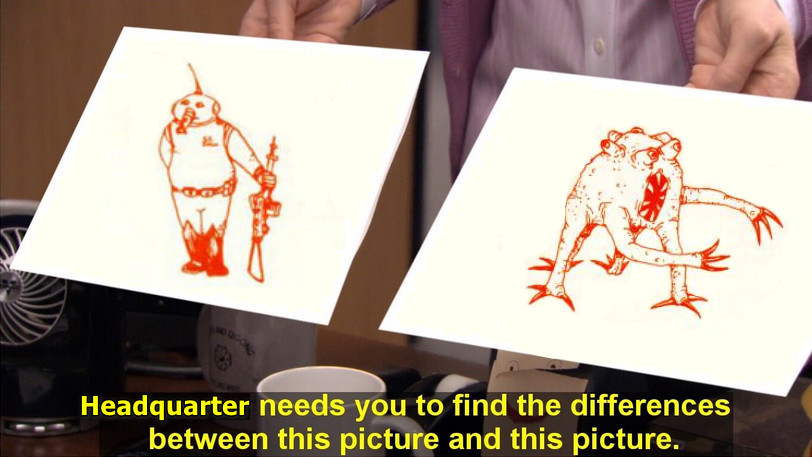
…errr the alien on the left looks nicer than the alien on the right ?
Perfect ! Just perfect ! I knew you would be the best man for the job. You will help the aliens on the left defeat the aliens on the right !
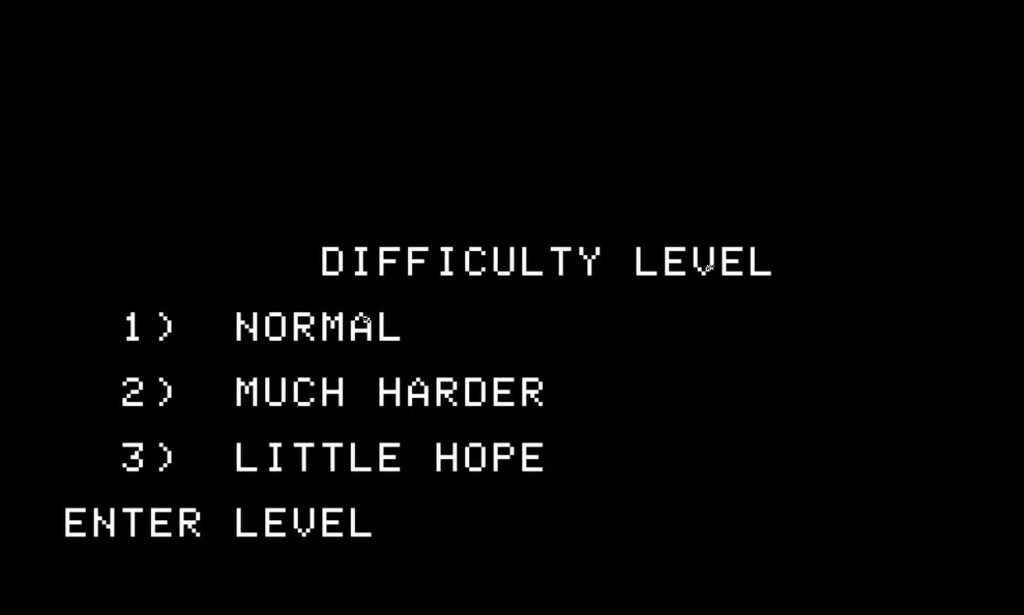
Space Station Zulu is a research and resupply station manned by a friendly, introspective and peace-loving race called the Yargs. I guess I should say that the station is “yarged” rather than manned. In any case, the station is properly organised : the 48 crewyargs are divided in 3 groups of 16 : two of those groups being frozen in suspended animation while the third group manages the station, with a rotation every three months. 16 individuals to manage a research and resupply station may not seem much, but they have 4 robots to help them with the menial tasks, so there is a lot of time for literal star-gazing. And of course, the station captain himself, yours truly, is efficiently organizing all these folks.
“So it came to pass that shortly after an exploration ship had left the station the computer notified the captain that the space station’s sanctity had been violated by unknown alien lifeforms. The computer had already deduced from various readings that the alien being had three stages of growth : spores, larvae and adults. It also surmised that the creatures were a deadly peril and appeared to be scattered throughout the station and that their numbers were increasing rapidly.”
Ruh-roh.

The first decision to take as the station captain (not “on-site”, or at least not represented in the game) is where to deploy the 16 active yargs and the four robots on the map.

I have some experience in the matter, having been a first-responder on a few other exactly similar alien infestations – I even saved a couple stations ! From previous experience, I know a few things :
- There are two “cryogenisation” rooms [room T and room S] in the center that must be absolutely yarged and protected. As long as there is one yarg and no alien in those rooms, a new yarg is unfrozen and can join the reaction force every turn, for each of the two rooms,
- The central room [room U] is absolutely strategic, as it is the only junction between the left half and the right half of the station. It is also the only room leading to the cryo rooms,
- At the beginning, there will be spores hidden in a good number of rooms ; finding and destroying those spores before they hatch is absolutely critical to the success of the cleaning operation. After the initial generation, spores will be generated by the adult aliens as they move around the station,
- Time is on the side of the aliens – sure the yargs can thaw 2 reinforcements by turn, but that’s only up to the limit of the number of available frozen yargs, meanwhile the alien numbers can grow exponentially if left unchecked.
Given the initial situation, I realize I have a good chance to clean-up the right side of the station early on if I immediately destroy the two alien groups and make sure I don’t miss any spores. Initially, the robots are the only ones that can consistently kill aliens, so I deploy two robots per group of aliens on the right (with some extra yargs for support), two yargs in the cryo room (to immediately check and then double-check for spores), a strong group of yargs in room U and the rest on the right side of the station, to scan for spores immediately :
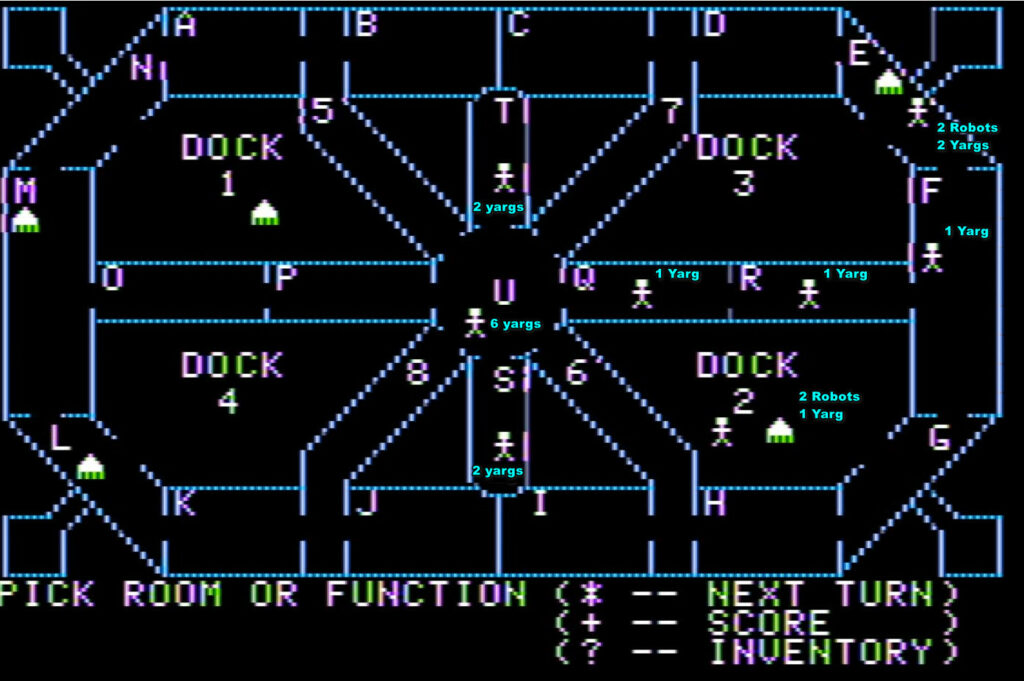
In room E, the two robots and two yargs I dropped confront two adult aliens. Yaaaaaarg, matey!
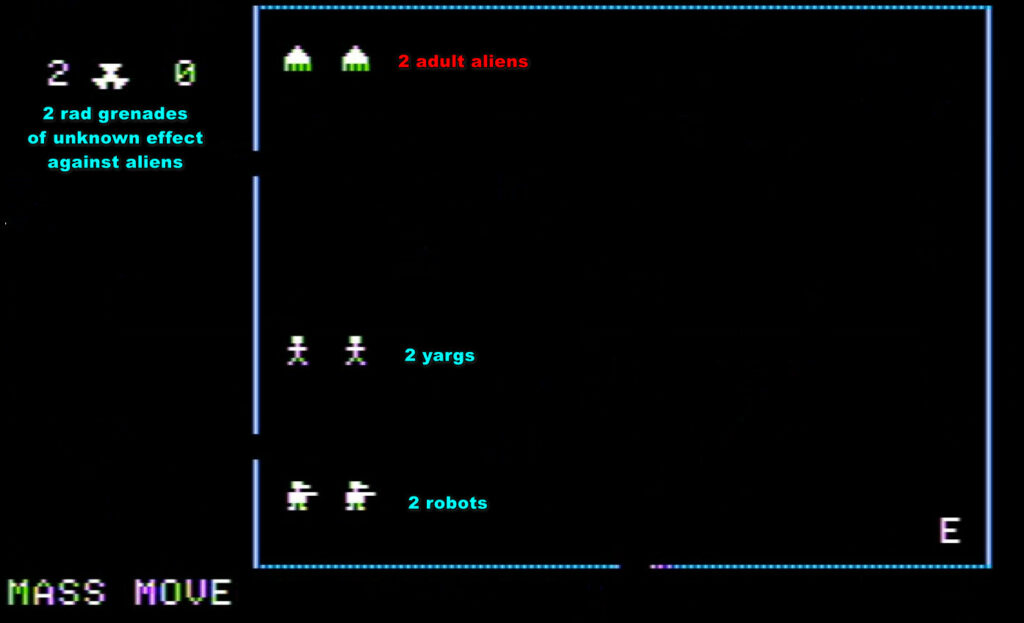
Aliens are ugly things, and the two yargs are unlikely to harm them without weapons. I have weapons in the room, more specifically radiation grenades, but until I test them, I have no idea what effect, positive or negative, the rad grenades will have on them. And I don’t want to test them right now.
There is a solution though – as I said the robots have a good chance to kill an alien :

I split my attack, and kill one alien :
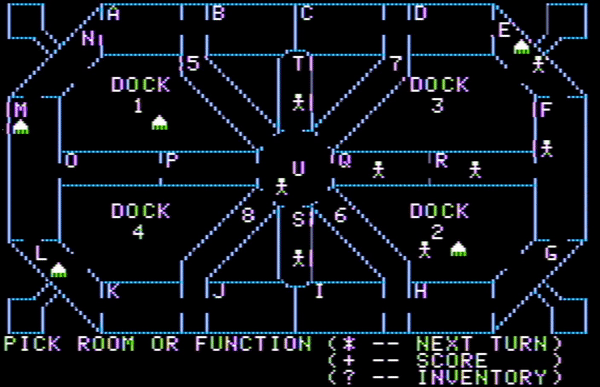
In dock 2, the situation is easier to handle : only two larvae – easy kills for my robots.
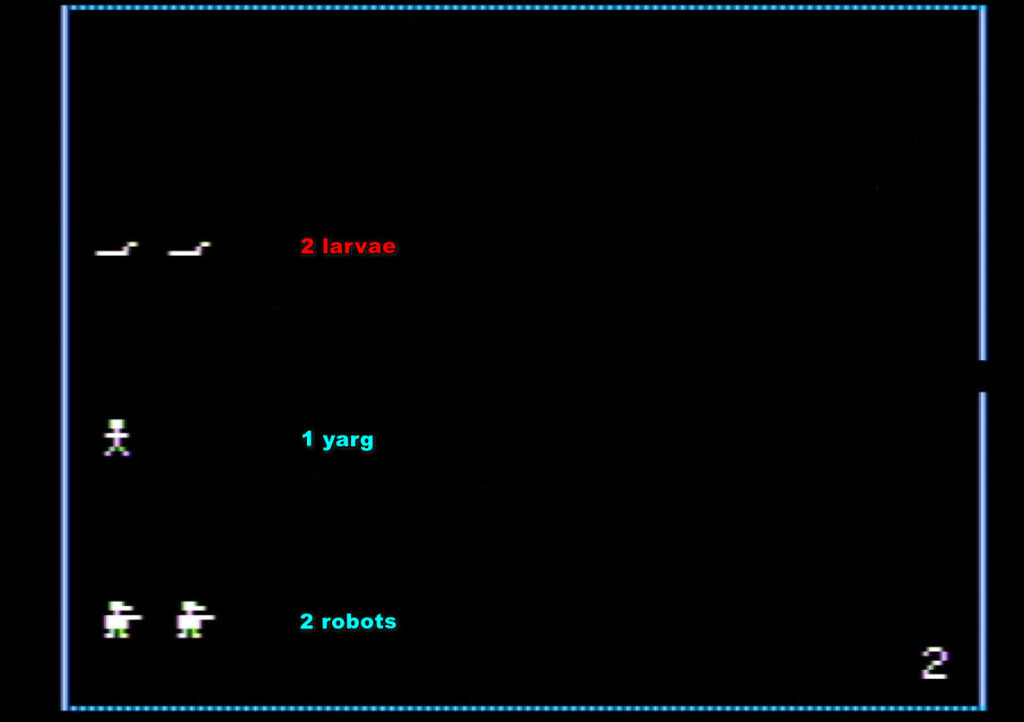
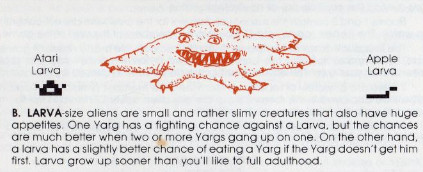
As for the rest of the room, I find and destroy some spores, including in rooms T and F. The cryo rooms are now cleared, so next turn the extra yargs and the future thawed yargs will move to room U.
In room U, one of the yargs indicates she is 100% sure there is no more spores in the room, so I start to spread out in the neighbouring rooms with the extra yargs.
And this is the end of the first yarg turn – and time for the aliens to play :
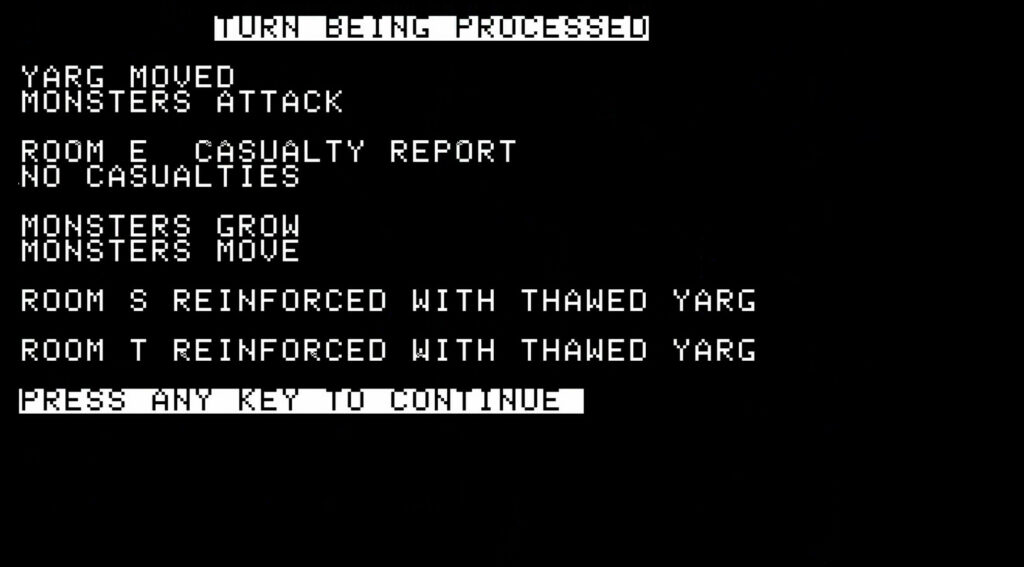
The surviving alien in room E retreats to dock 3. No shuttle to Earth for you though, and my robots are in pursuit. They will not be able to attack before the next turn though, as it is movement OR attack. One yarg remains behind to search for spores.
Some spores hatch in room 8 and the larvae immediately move to the central room, while another larva moves to room P where I had sent a scout.
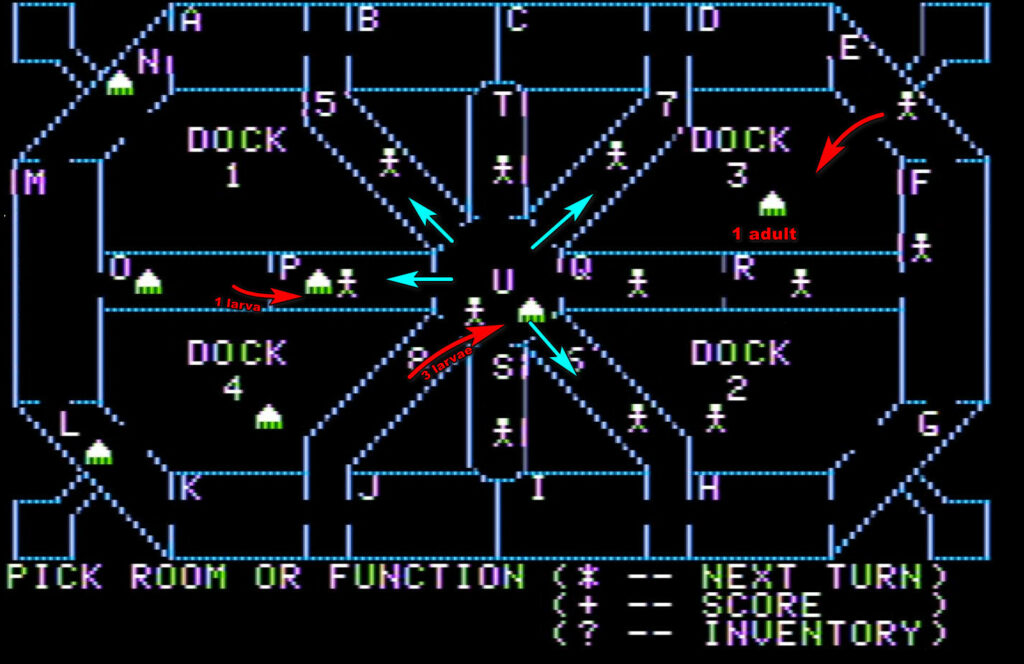
The situation in room U is not great : the 3 larvae outnumber my yargs, but I get lucky and eliminate two. On the other hand, the duel against that larva in room P is fruitless. At least next turn I will have yargs pouring from rooms T and S to solve that problem.
I am VERY happy to have sent a scout to room 7, as I find 3 spores there. They initially resist my yarg’s furious stomping, but they will eventually be destroyed the following turn.
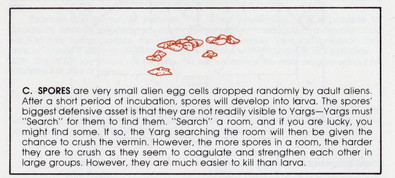

The following turn, I also finish off the escaped alien in dock 3 and find myself in a very interesting situation in room U :
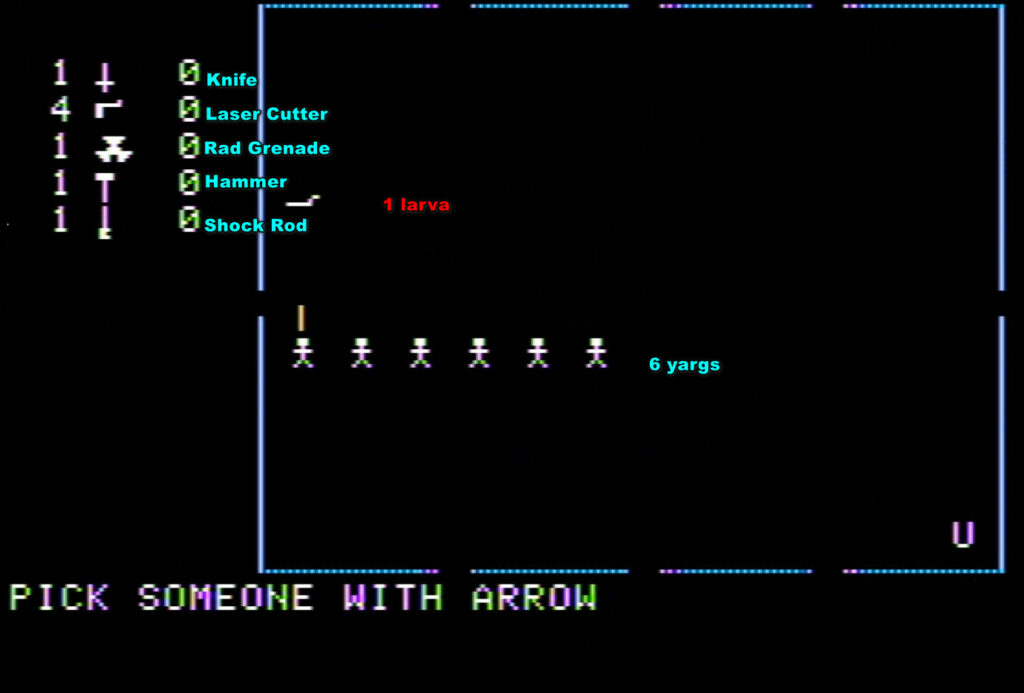
There is only one larva, I am almost certain to kill it. It means it is the ideal time to start testing weapons. You see, there are a bunch of tools and weapons scattered across the space station, but their effects on the aliens are unknown until they are actually used against them. Some of these will harm the aliens, some will be totally ineffective, and some will help the aliens grow or reproduce – a big no-no in a difficult battle. But if I have 4 yargs beating up a larva, even if one of the weapons I test helps the alien, well it won’t save it. Consequently I test the laser cutter and the radiation grenade. It turns out the laser cutter is inefficient and the rad grenade help the aliens grow, but the larva is killed nonetheless.
And with this, I cleaned up the right side of the space station of active aliens. In the following turns, my yargs will comb through each room looking for spores, stomping a couple more.
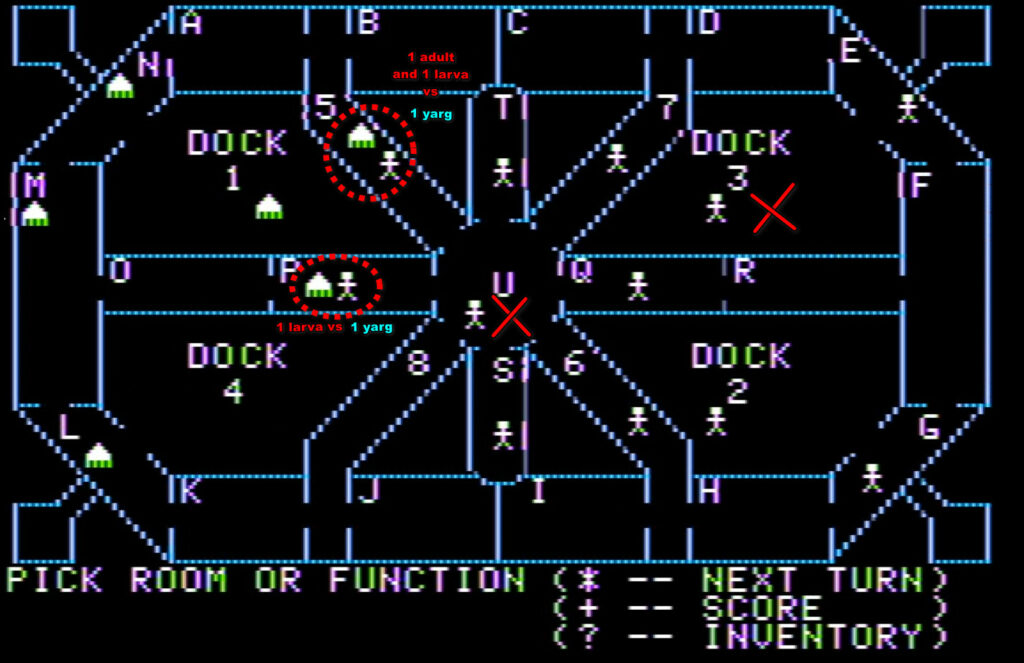
On the left side though, I am engaged by a bunch of aliens in rooms 5 and P. I order my yargs to “defend”, and they survive for now.
The following turn, I have quite an army in U (due to reinforcements coming from rooms T, S but also Q where one of my crewyargs was unoccupied and at risk of resuming his stargazing:
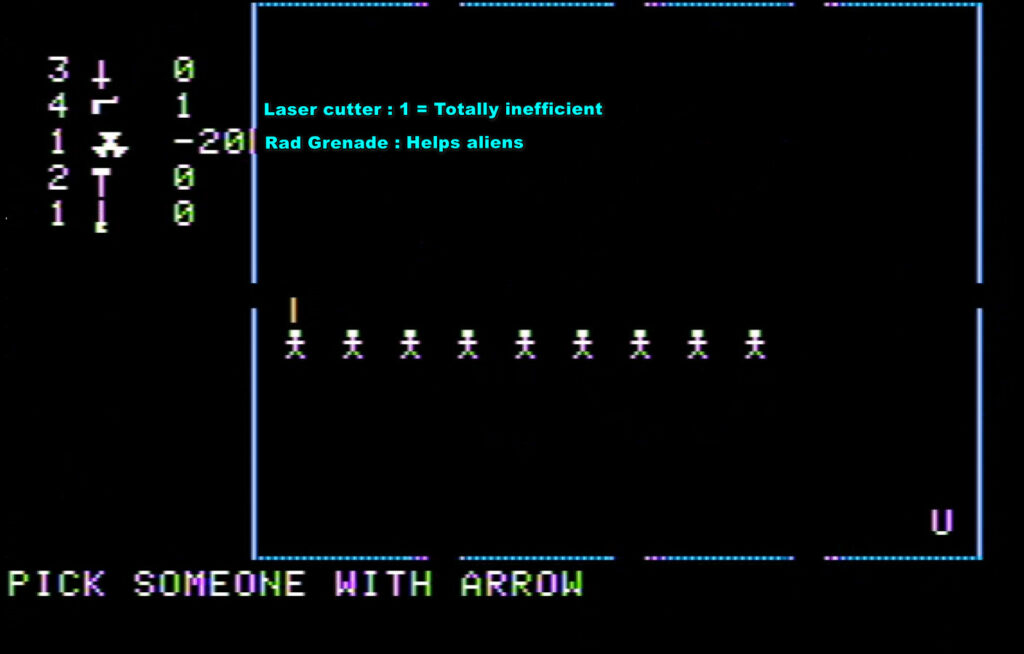
That large army is allocated mostly to room 5 with a small group reinforcing room P, which hosts only one larva. What I had not noticed is that said larva had actually grown up to be an adult, and got joined by another alien (who knows, maybe its first alienfriend – they grow up so fast).
Consequently, I have my first losses :
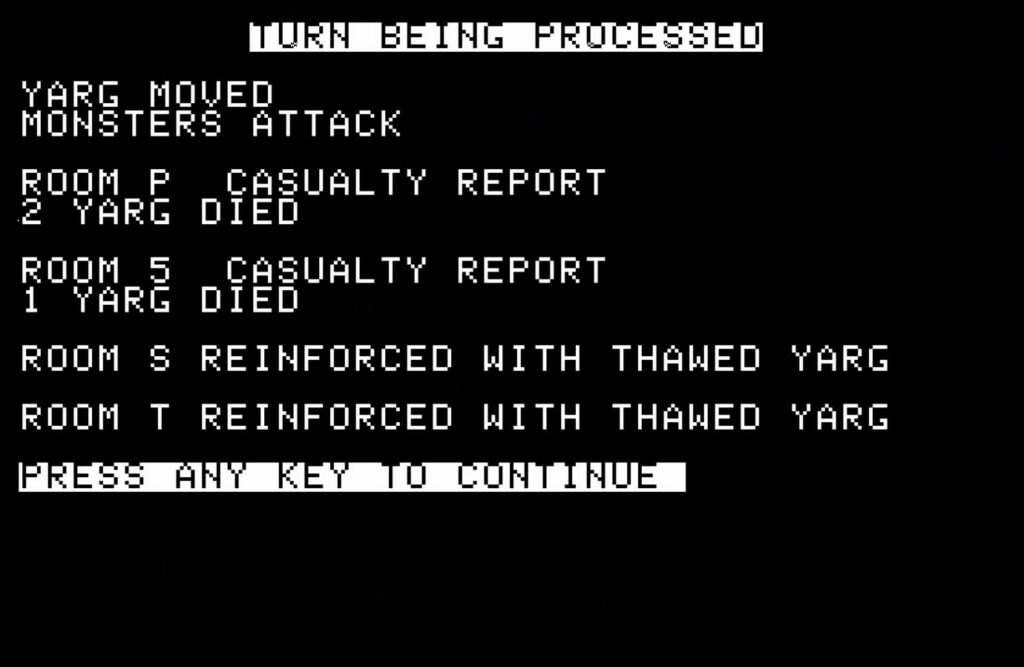
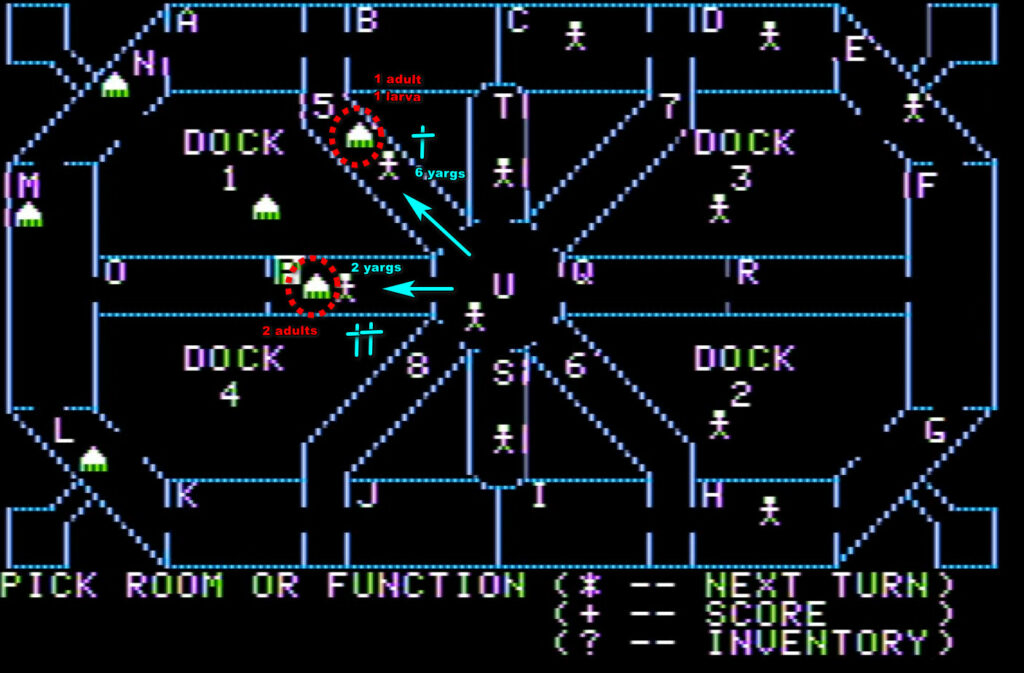
No matter, I attack the adult in room 5 with all my yargs and their puny little fists. The adult is killed. The larva wisely flees to room A, followed by my group.
The two yargs in room P defend as they can, before being joined by another large group of yargs – keep in mind that at this point I have thawed around 12 yargs, lost 3, so with the robots I can rely on close to 30 units in total, with as always 2 more coming every turn.
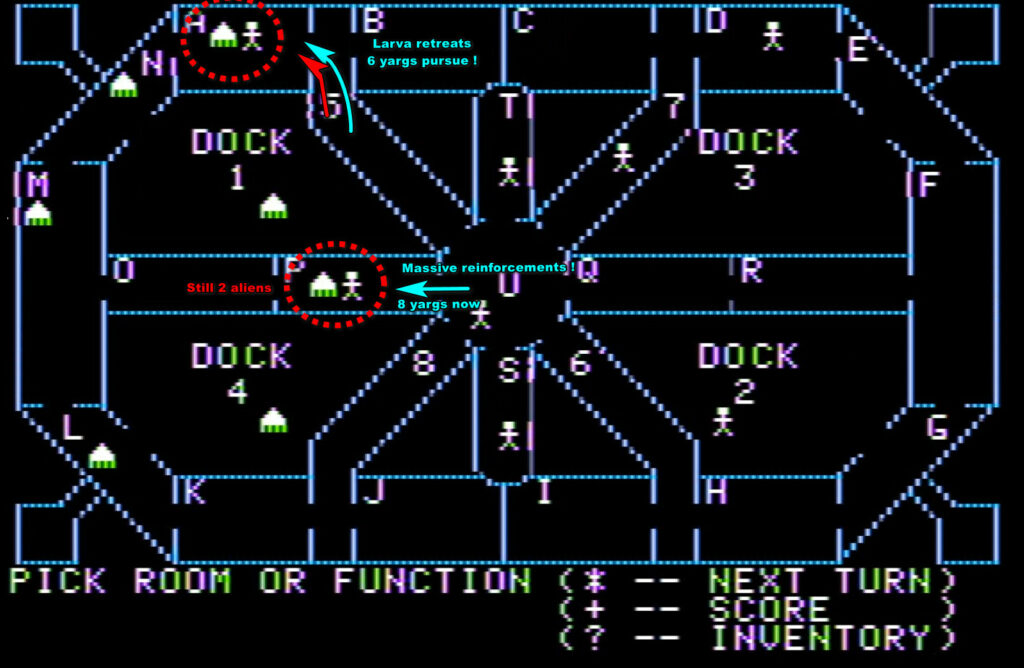
My pursuit in room A allows me to test some more weapons : hammer and knife.
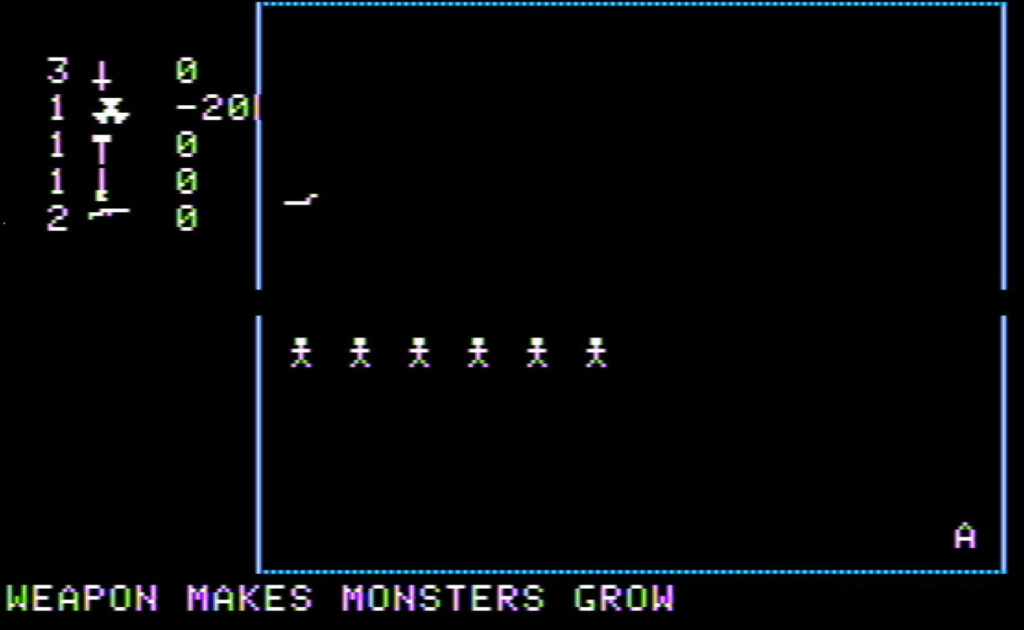
Well, knife is useless, the hammer helps the aliens – two weapons my little troops still in the right part of the space station will not have to bring to room U. The now-adult alien does not stick around and falls back to room N.
For the sake of brievity, let’s just say that a combative back-and-forth carries on for several turns along the room O- room P corridor and the room A – room N corridor. Eventually, after the loss of a robot, the loss of several yargs, the destruction of a bunch of aliens, some opportunistic weapon testing and finally confusion & panic as some aliens attempt a mad dash under fire for room U (which one lone alien manages to reach before being killed), I manage to corner the aliens in dock 1 and dock 4.
Is it the end for the aliens ?
Not quite yet !
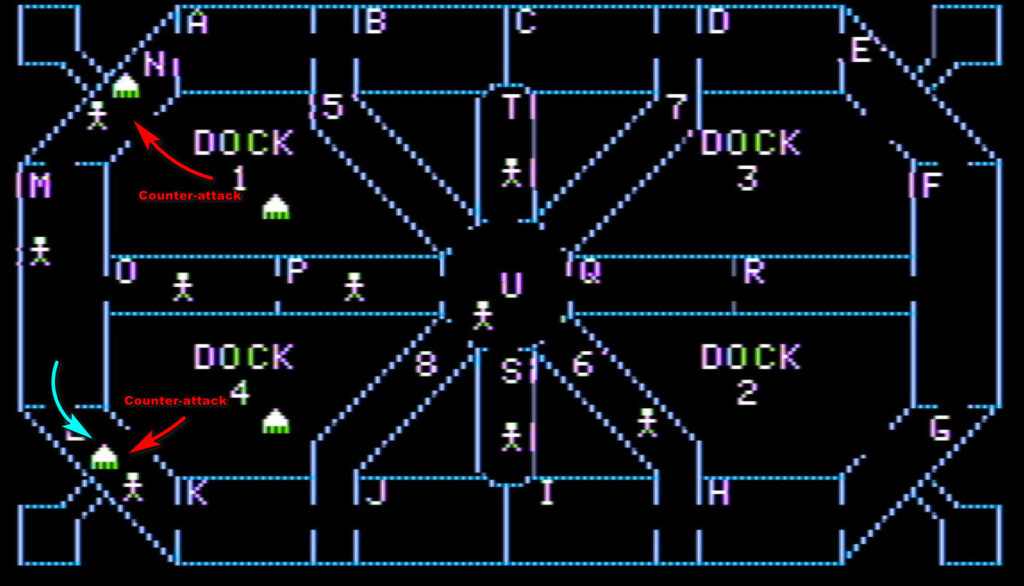
In room L, my task-force is underyarged after I had split it earlier on to pursue those aliens trying to force their way toward room U. The aliens don’t miss this, and they attack with a decisive advantage in numbers. I could try to retreat, but I prefer to make a stand and gain some time.
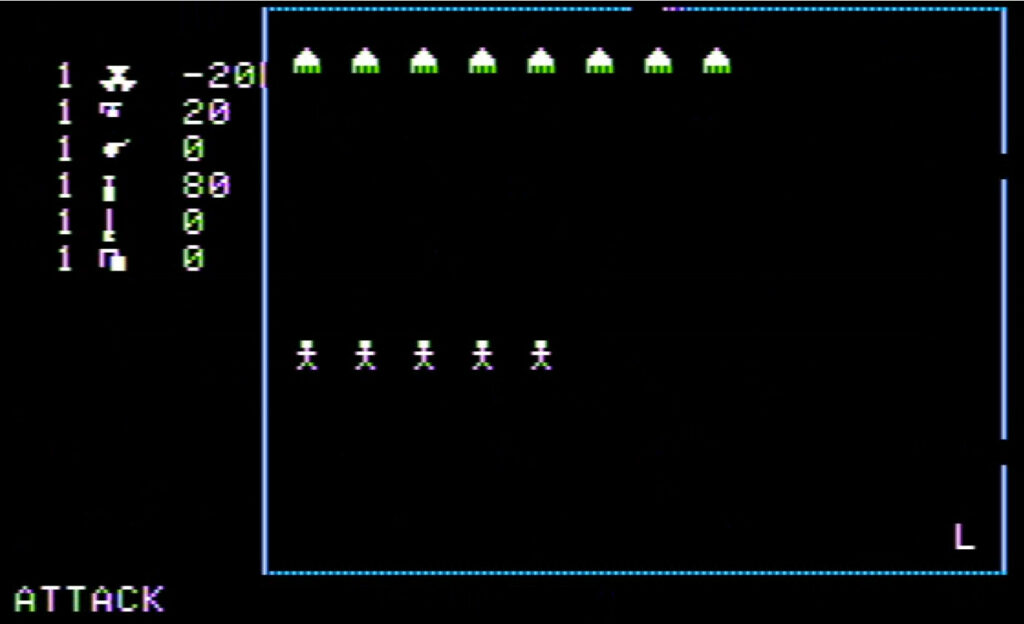
In room N, my yargs-at-arms are more numerous, so the threat is less severe. Still, I spread out my attacks too much and only kill one alien :
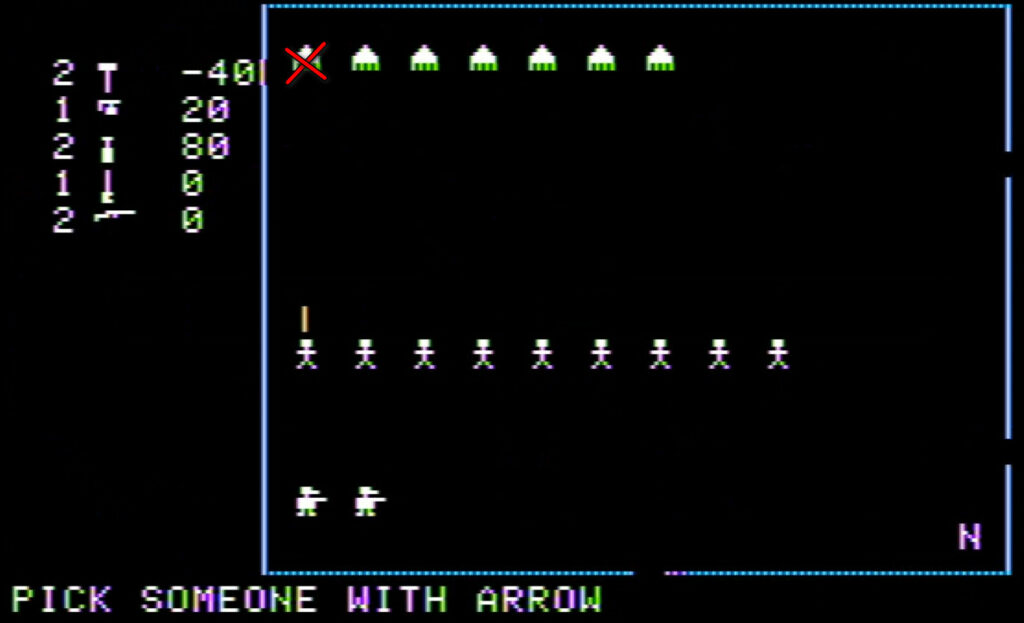
Losses during the alien turn are catastrophic :
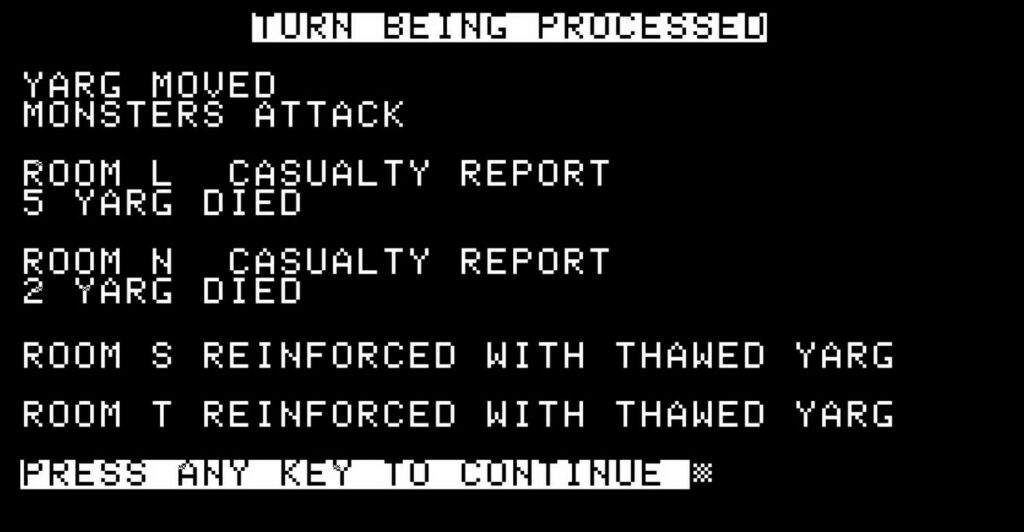
That’s a full party wipe in room L. Room N only managed better because, I believe, the aliens focused on the robots and failed.
Nonetheless, I finally prevail – with some significant losses – in room N, and I am now moving to dock 1 to finish off the stragglers. Meanwhile, reinforcements pour through the central corridor. At this point I don’t need yargs any more in the right part of the space station, so I can throw a lot of bodies at my problem : aliens !
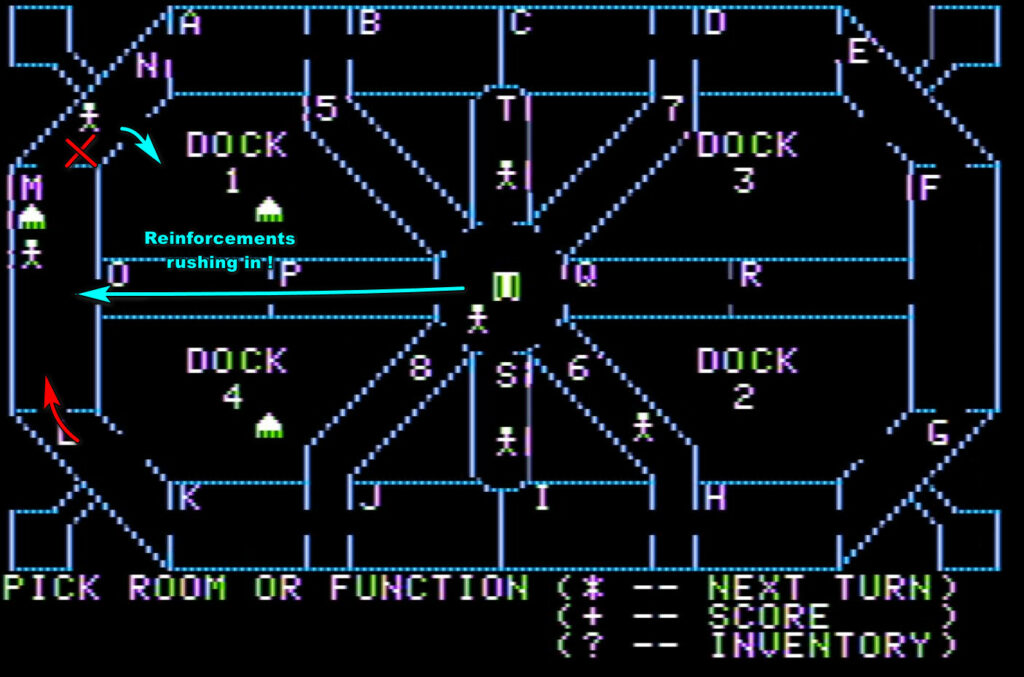
Dock 1 has an unexpected issue though : while I am moving into the room, a lot of spores burst open, and larvae are crawling everywhere :
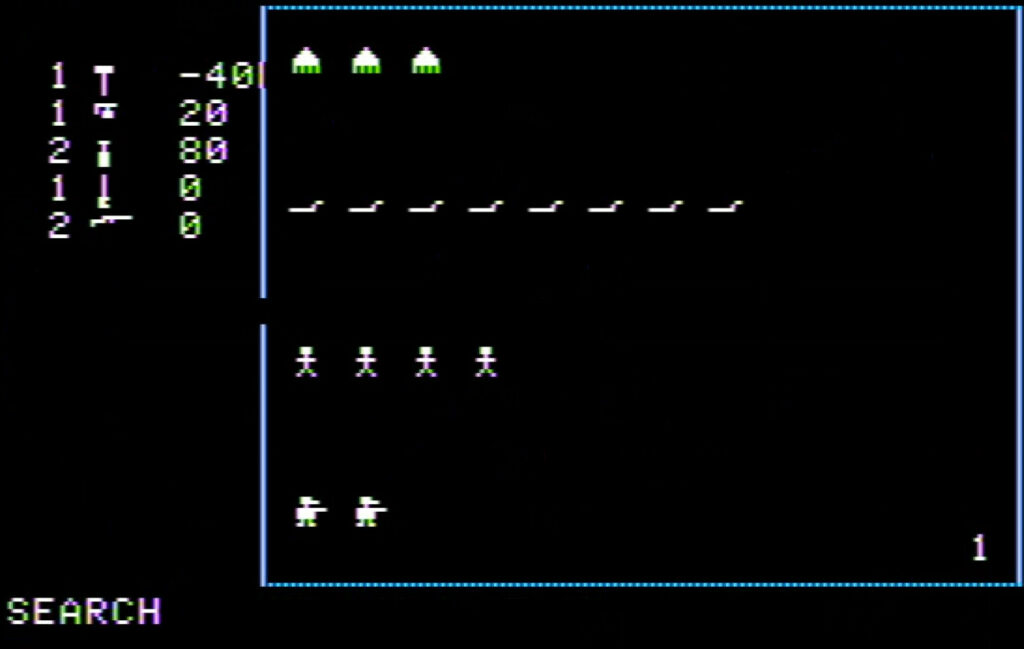
Time for my trump card …

Only one yarg escaped before the explosion. The second robot and one yarg were killed as they tried to flee, and as for the two last yargs, well, I needed to test those two remaining weapons (the shock rod and the rifle).
After a massive melee and colossal losses, I also take control of room M :
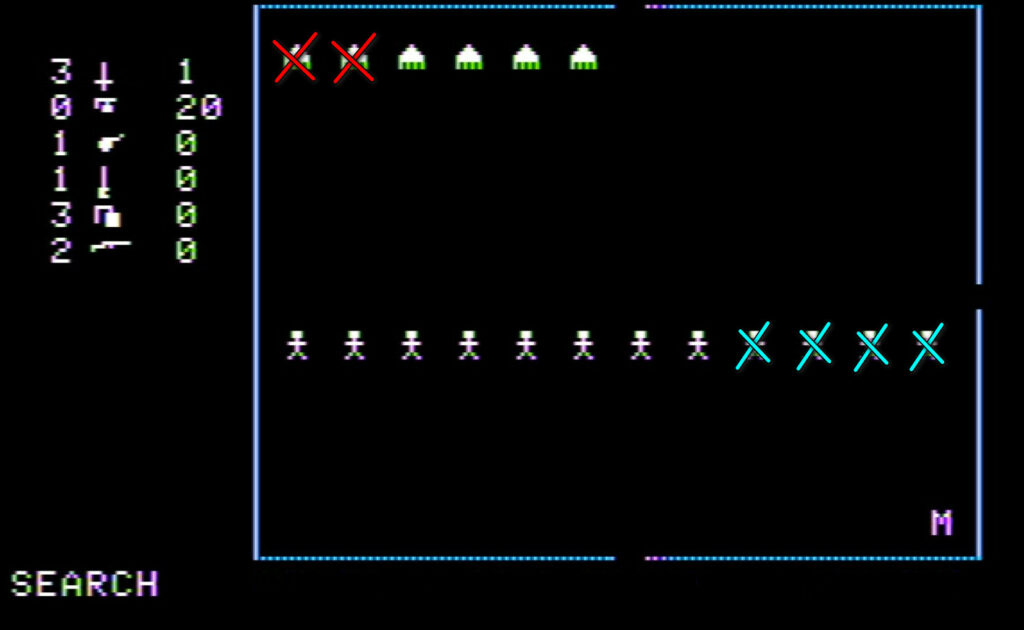
The last aliens are now hidden in dock 4, only 4 aliens and 2 adults. I am gathering most of my forces for a final assault :
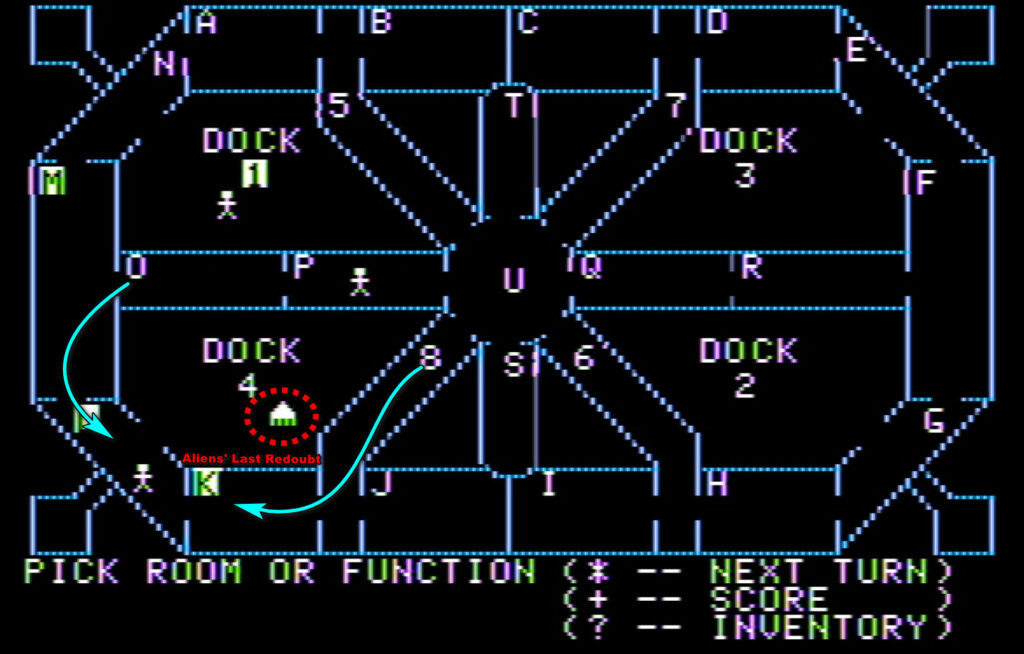
15 yargs and the last robot. I assault the room, losing 2 yargs as I enter the room. The robot stays near the entrance, to kill any alien thinking of retreating, by self-destructing if needed.
But the aliens make a final stand :
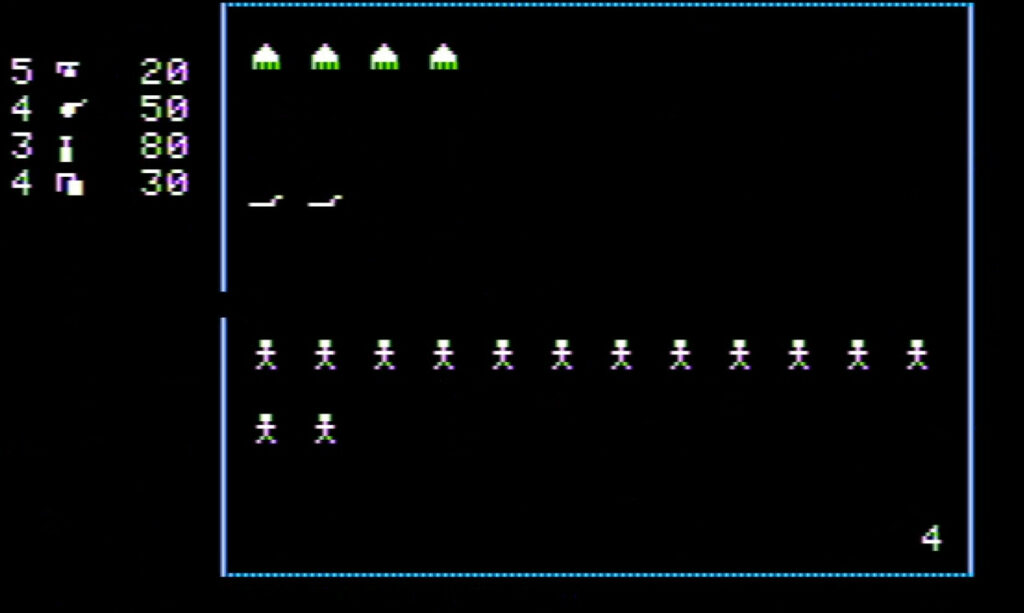
And killing the last aliens over two turns (one larva survived longer than expected), I can finally announce that Space Station Zulu is saved !
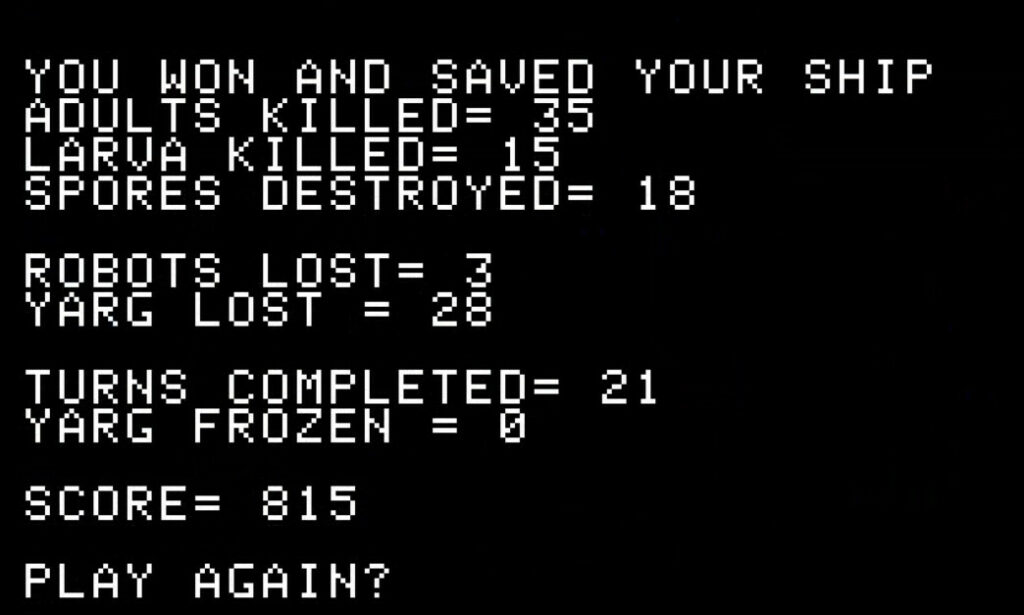
Rating and Reviews
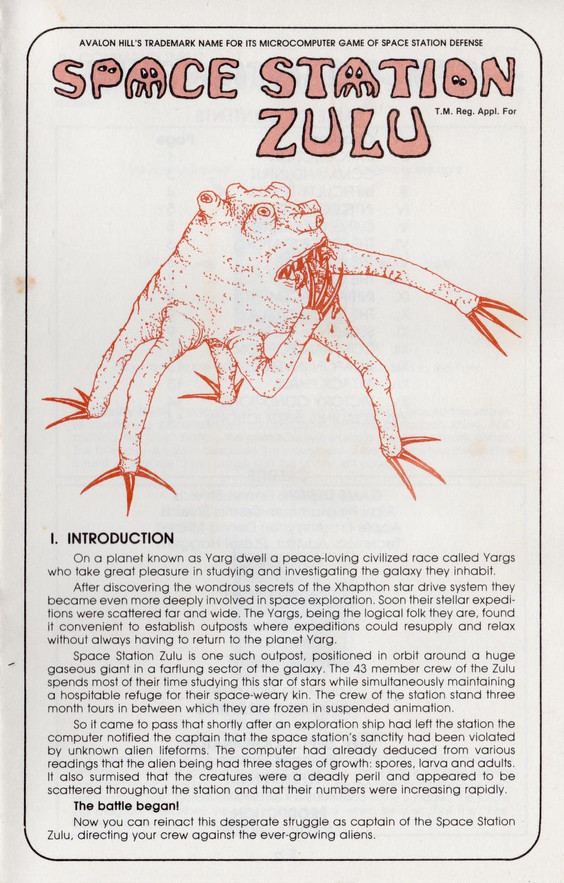
Space Station Zulu by Dennis Shields, published by Avalon Hill, USA
First release : January 1983 on Apple II and atari
Tested on : Apple emulator
Total Hours Tested : 6 hours
Average duration of a battle : 1 hour
Complexity : 1/5
Would recommend to a modern player : No
Would recommend to a designer : Yes, but one should probably play the boardgame instead
Final Rating: Interesting
Space Station Zulu is part of the late 1982 – early 1983 Avalon Hill releases, a batch particularly rich in wargames as it includes Space Station Zulu but also The Alien, Fredericksburg and Close Assault. I had some dating challenges there. Sure, all those games were released in 1982 according to the Trademark, Wikipedia and Mobygames. But the four games are missing from any Avalon Hill 1982 catalogue and were first announced as available in the January-February 1983 issue of Avalon Hill’s magazine “The General”. Decisively, they are not part of Computer Gaming World‘s list of 1982 releases, nor did they receive any other mention in 1982 except as “work-in-progress” games. Due to this, I am inclined to believe the four games started being distributed in January 1983.
I have nothing to say about Dennis Shields, credited as the designer of the game. As far as I can tell, he did not work on any other project, in any position. Dennis Shields took a lot of “inspiration” from The Awful Green Things from Outer Space (TAGTFOS), a very popular TSR boardgame from 1979 by Tom Wham – something that obviously Avalon Hill never stated anywhere. Tom Wham on the other hand fully admits he took his own inspiration from The Green Slime, a Japanese C-movie from 1968.
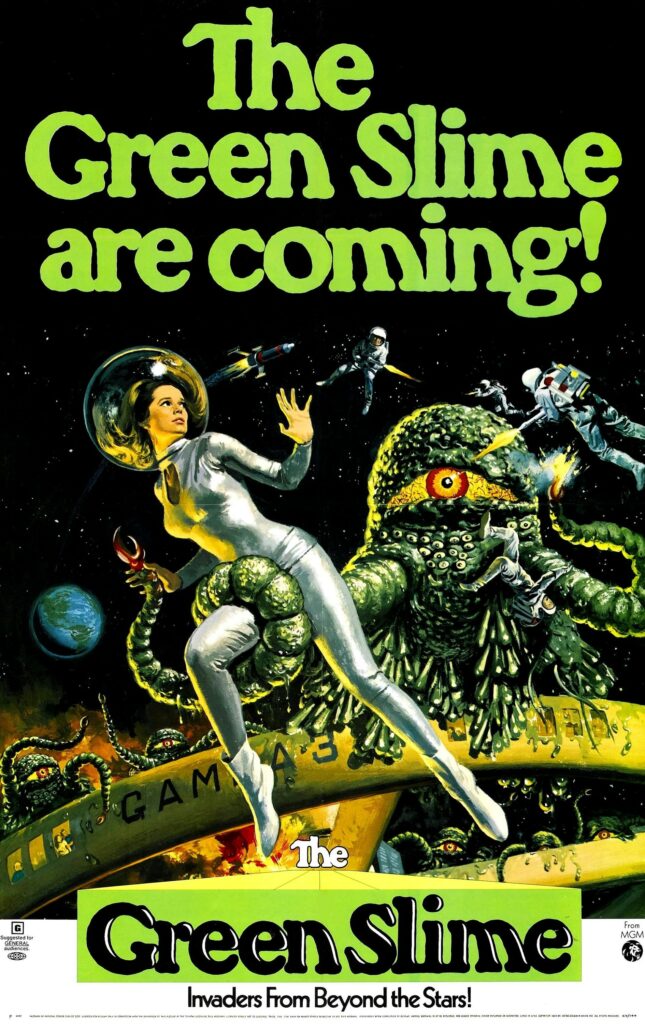
There are a lot of mechanics in TAGTFOS that made it to Space Station Zulu : the growth stages of the alien (egg/spore, baby/larva and adult), the weapons with unknown effects until they are used, the combat system, even the robots (though there is only one in TAGTFOS). There are a handful of differences, in general in favour of TAGFTFOS :
- TAGFTFOS has individual, named characters, with individual stats,
- Weapons in TAGFTFOS have different uses (melee, explosions), even if their exact effect is unknown,
- TAGFTFOS has optional rules to fight aliens in zero-G outside the ship,
- TAGFTFOS does not have frozen Yargs – everyone in the crew starts already awoken,
- In TAGFTFOS, the crew can try to evacuate the station in all sorts of shuttles, if the situation turns desperate. There is even a weird “mini-game” to determine what its ultimate fate in outer space is,
- In TAGFTFOS, the robot cannot self-destruct… but the crew can detonate the whole station

The comparison with TAGFTFOS may not be to Space Station Zulu‘s advantage, but how does it stand on its own ?
A. Immersion
Space Station Zulu has a well-written manual, with an amusing description of the whole situation. Sadly, the humor stops when the game is launched – the game is as dry as the average SSI game.
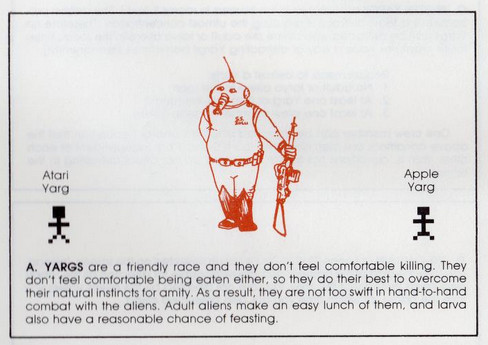
Despite the lack of graphics (even for 1983), the game conveys the important things, and it really feels like a race against time. A typical game goes through the typical steps of any “unexpected visitor” movie : first containing the threat as much is possible, then figuring out what can kill the creatures, then the final assault. Almost inevitably, this includes containment breaches and panicked moves.
Overall, the game punches above its weight.
Rating : Adequate
B. UI , Clarity of rules and outcomes
The command of Space Station Zulu is extremely simple : pick a room, then give an order to every single yarg and robot in that room. A yarg or a robot can only do one action by turn, between SEARCH, MOVE, ATTACK, USE WEAPON, PASS, DEFEND/SELF-DESTRUCT and EVADE (which is exactly like moving, but is used when there is an alien in the room).
The problem is that the game (on Apple II at least) was made for the paddle, so there are only two buttons used in the game for unit control : cycle and confirm. This means that to give a MOVE order to a yarg you need :
- To cycle through the yarg and robots (which is acceptable, since you will give one order to each of them anyway)
- Cycle through all the possible orders,
- Then cycle between UP, DOWN, LEFT and RIGHT, even if there is only one direction/exit in the room,
- Then cycle through the different rooms that are in this direction (for instance, there are 3 rooms “North” of room U)
- Confirm whether the yarg takes a weapon with him,
- If yes, cycle through the weapons to select one,

There is a short-cut to give the same order to several yargs at the same time (“MASS MOVE”), but of course it only applies to the yargs in the same room. Overall, it takes a long time to move, time that would have been cut with a better UI.
Another issue with the two-buttons system is that there is no way to cancel an order. Let’s say you give a “USE WEAPON” order to a yarg, then realize that all the weapons are going to help the aliens, you have no way to roll back.
That’s for the UI. As for the clarity of outcomes, the game does not deliver either. The worst issue I found is on alien escape. Just like yargs and robots, aliens can escape a room occupied by their enemy, and when they try to do so, sometimes they are killed, sometimes they are blocked and lose their turn, and sometimes they succeed. Frustratingly, the game does not tell you when aliens were killed trying to flee – you need to count the aliens every turn.
Rating : Terrible.
C. Systems
I have explained everything through the AAR except maybe the combat system. Combat favours the defender significantly, as whoever enters the room occupied by an enemy lets the latter have the first strike. In combat, each player allocates its combatants to enemy targets, and those combatants do a combined attack that must pass a threshold : 10 for larvae and 20 for adults.
From what I understand, the attack value seems to be :
- From 1 to 12 for yargs,
- From 1 to 25 for robots,
- When using weapons, the attack value used is the one of the weapons, so ranging from 1-20 to 1-80 for good weapons, and from 0 to -40 for weapons that turn out to actually help the aliens.

Of course, this means it is better to equip the robots last, and not give them any +20 weapon.
As for weapons that help the aliens, detecting them safely is a large part of the early game, up to a point where sometimes I try to make sure one larva survives at the end of a turn so I can experiment on it the following turn. In my experience, a -40 weapon can create as many as 10 larvae !
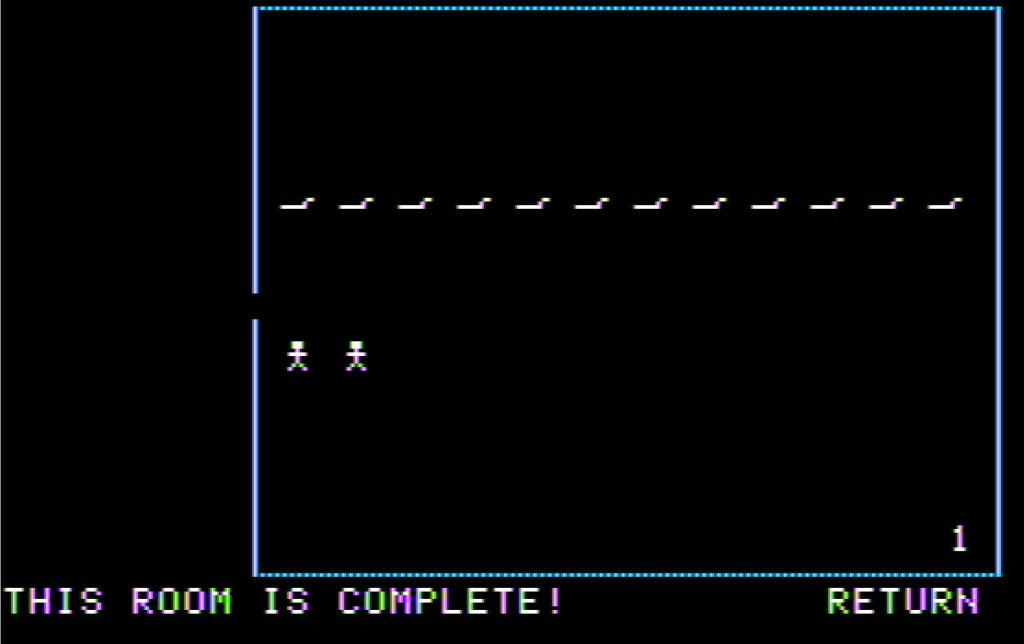
End of turn : 12 larvae and a lesson learned
Overall, the system works very well, though I wish it was a lot more like The Awful Green Things from Outer Space : different ways to use the weapons, more diversity than just yargs and robots.
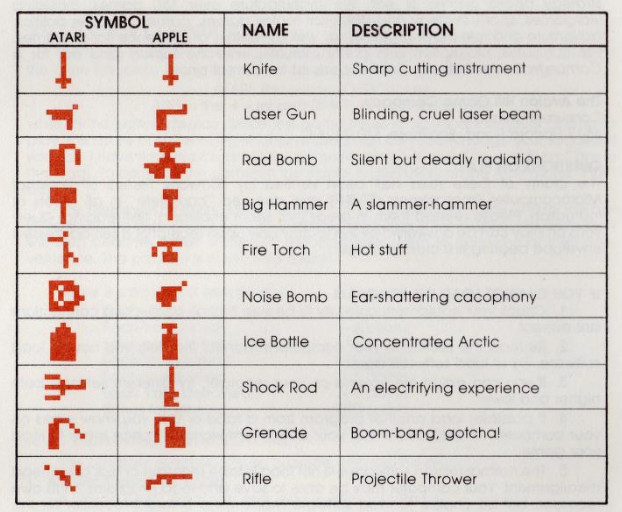
Rating : Quite good
D. Scenario design & Balancing
The game has 3 difficulty levels and an additional option to choose whether or not you see the aliens on the mini-map. In my experience, invisible aliens at the easiest difficulty level are about as tricky as visible aliens at the hardest difficulty level : you never know whether an alien has actually hatched in a room you believe safe, or whether you are going to march in a large group of aliens which will get to shoot first. I believe it would also have made a poor AAR (“I enter room M and find… 12 aliens ! All my yargs die“).
The AI is solid : it tries to retreat sometimes, it will agressively move to attack isolated yargs, it will try to occupy the cryo rooms, and it will focus on the robots at every opportunity, since they are the only ones able to safely clear a very large concentration of aliens.
The player needs to be very aggressive, especially in the hardest difficulty. If the aliens are left alone, they can multiply up to an unbeatable number, except by robot self-destruction, but even then the robot would need to survive the aliens’ first strike before detonating. Meanwhile, the player can run out of yargs.
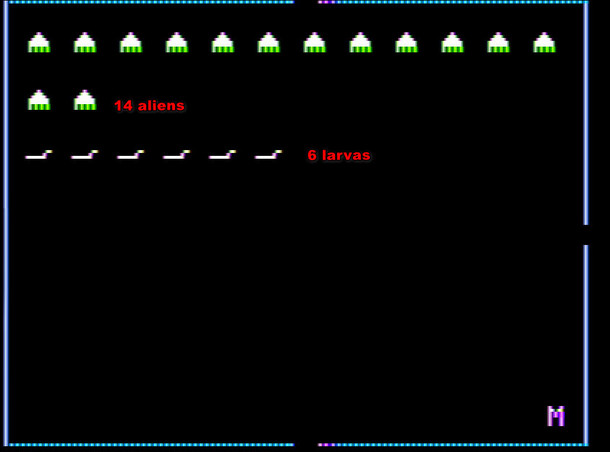
I wish the game had more diversity on the map, with the location of the cryo room or whether some rooms connect to other randomized ; sadly the only randomization is on the initial alien number and location so most runs look similar at some point.
Final nitpick : the game has a weird way of tallying points, with too many points given for killing aliens. In short games where I managed to control the infestation quickly and lost very few yargs I ended up with fewer points than in the mutual bloodbath.
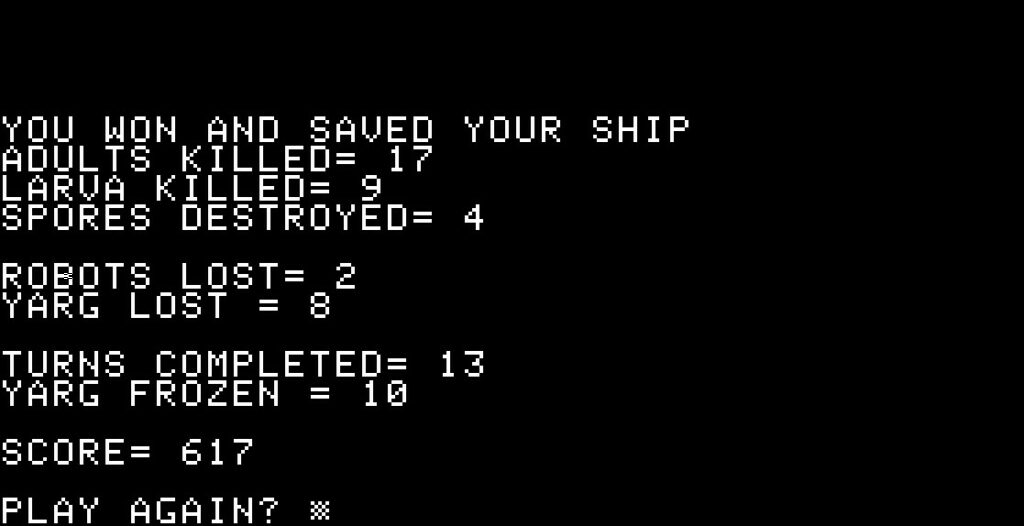
Rating : Adequate
E. Did I make interesting decisions
Yes, every turn : where to send troops, when to test weapons, when to attack and when to wait for more reinforcements.
I just wished executing those decisions did not take so goddamn long !
F. Final rating
Interesting ! The game is well-designed (even if derivative) and its board-game nature has allowed it to remain interesting today. It is really pulled down by its terrible UI and long playing time for what it is, so I don’t feel I can recommend it to a modern player, but for 2 or 3 sessions it does things that I haven’t seen in other games so far, so I cannot call it obsolete either.
Contemporary Reviews
Space Station Zulu was probably too tactical for arcade players and not serious enough for strategy players, and failed to generate much interest at its release. I only found an handful of reviews that were longer than a few lines :
- In September 1983, Softtalk explains that Space Station Zulu “is not bad game”, but not as good as its Avalon Hill sibling The Alien : “Space Station Zulu would serve best as a training ground for people trying their first computer simulation.”
- Computer Gaming World is way more positive in December 1983 calling the game an “excellent strategy simulation” in one of its micro-reviews.
- The Book of Apple Software complains that the game is “too slow and ponderous“, that “the graphics are nothing to write Earth about“, and gives the game a C+ with the added cryptic comment “a really fine military tactician might have a chance” (?).
I am looking forward to fighting more aliens in, well, The Alien, and see whether Softtalk is correct in its comparison. But as I found out that The Alien was also released in 1983, so this will have to wait a bit.